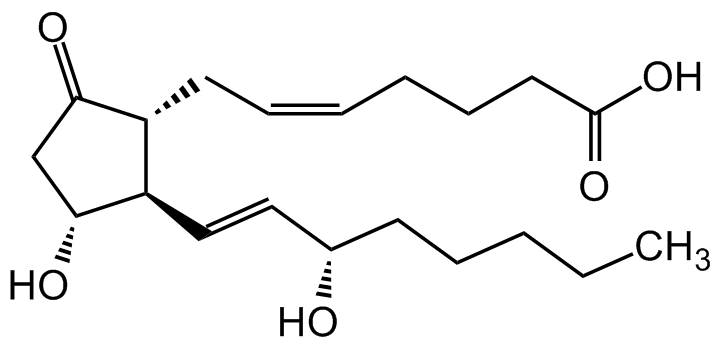
Chemical Structure
Prostaglandin E2
CDX-P0318
CAS Number363-24-6
Product group Chemicals
Estimated Purity>98%
Molecular Weight352.47
Overview
- SupplierChemodex
- Product NameProstaglandin E2
- Delivery Days Customer10
- CAS Number363-24-6
- CertificationResearch Use Only
- Estimated Purity>98%
- Hazard InformationDanger
- Molecular FormulaC20H32O5
- Molecular Weight352.47
- Scientific DescriptionChemical. CAS: 363-24-6. Formula: C20H32O5. MW: 352.47. Prostaglandin E2 is one of the most typical lipid mediators produced from arachidonic acid (AA) by cyclooxygenase (COX) as the rate-limiting enzyme and acts on four kinds of receptor subtypes (EP1, EP2, EP3 and EP4) with high binding affinity. It is a regulator of numerous physiological functions ranging from reproduction to neuronal, metabolic and immune functions. It acts as a pro-inflammatory mediator, but also exerts anti-inflammatory responses. As pro-inflammatory mediator, PGE2 contributes to the regulation of the cytokine expression profile of DCs and has been reported to bias T cell differentiation towards a T helper (Th) 1 or Th2 response. It exerts anti-inflammatory actions on innate immune cells like neutrophils, monocytes and NK cells. Prostaglandin E2 also facilitates tumor progression through stimulation of angiogenesis via EP2, mediates cell invasion and metastasis formation via EP4 and promotes cell survival by inhibiting apoptosis via numerous signaling pathways. Recently it has been shown to inhibit NLRP3 by acting through receptor EP4 activation that increases cAMP. cAMP activates PKA that phosphorylates NLRP3 at serine 295. PKA phosphorylation of NLRP3 inhibits the NLRP3 ATPase activity, which is required for assembly of NLRP3-ASC complexes. - Prostaglandin E2 is one of the most typical lipid mediators produced from arachidonic acid (AA) by cyclooxygenase (COX) as the rate-limiting enzyme and acts on four kinds of receptor subtypes (EP1, EP2, EP3 and EP4) with high binding affinity. It is a regulator of numerous physiological functions ranging from reproduction to neuronal, metabolic and immune functions. It acts as a pro-inflammatory mediator, but also exerts anti-inflammatory responses. As pro-inflammatory mediator, PGE2 contributes to the regulation of the cytokine expression profile of DCs and has been reported to bias T cell differentiation towards a T helper (Th) 1 or Th2 response. It exerts anti-inflammatory actions on innate immune cells like neutrophils, monocytes and NK cells. Prostaglandin E2 also facilitates tumor progression through stimulation of angiogenesis via EP2, mediates cell invasion and metastasis formation via EP4 and promotes cell survival by inhibiting apoptosis via numerous signaling pathways. Recently it has been shown to inhibit NLRP3 by acting through receptor EP4 activation that increases cAMP. cAMP activates PKA that phosphorylates NLRP3 at serine 295. PKA phosphorylation of NLRP3 inhibits the NLRP3 ATPase activity, which is required for assembly of NLRP3-ASC complexes.
- SMILESO=C1C[C@@H](O)[C@H](/C=C/[C@@H](O)CCCCC)[C@H]1C/C=C\CCCC(O)=O
- Storage Instruction-20°C,2°C to 8°C
- UNSPSC12352200

![Prostaglandin E2 [363-24-6]](https://www.targetmol.com/group3/M00/37/BF/CgoaEWayUWeETcHxAAAAAHxNTmw685.png)

